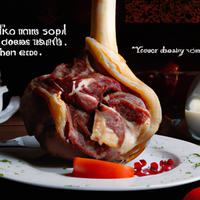
1 serving (100 grams) contains 250 calories, 26.0 grams of protein, 15.0 grams of fat, and 0.0 grams of carbohydrates.

Log this food in SnapCalorie

Nutrition Information
Calories |
595.2 | ||
|---|---|---|---|
% Daily Value* |
|||
| Total Fat | 35.7 g | 45% | |
| Saturated Fat | 14.3 g | 71% | |
| Polyunsaturated Fat | 0 g | ||
| Cholesterol | 190.5 mg | 63% | |
| Sodium | 178.6 mg | 7% | |
| Total Carbohydrates | 0 g | 0% | |
| Dietary Fiber | 0 g | 0% | |
| Sugars | 0 g | ||
| protein | 61.9 g | 123% | |
| Vitamin D | 0 mcg | 0% | |
| Calcium | 23.8 mg | 1% | |
| Iron | 6.2 mg | 34% | |
| Potassium | 761.9 mg | 16% | |
* Percent Daily Values are based on a 2,000 calorie diet. Your daily values may be higher or lower depending on your calorie needs.
Food Attributes
Source of Calories
About Cow leg
Cow leg, a staple in various culinary traditions such as African, Caribbean, and Asian cuisines, is a rich source of collagen, gelatin, and essential nutrients. Often used in soups, stews, and slow-cooked dishes, it is prized for its ability to create deep, flavorful broths. Cow leg is high in protein, which supports muscle repair and growth, and contains important minerals like calcium, phosphorus, and magnesium that contribute to bone health. However, it is also relatively high in fat, especially saturated fat, which should be consumed in moderation. Its high collagen content makes it beneficial for joint health and skin elasticity, making it a favored ingredient in diets focused on these areas. While nutrient-dense, cow leg is best enjoyed as part of a balanced diet, prepared in ways that avoid excessive added fats or sodium.



